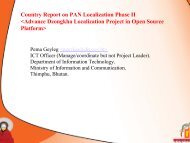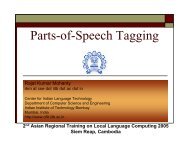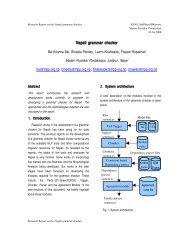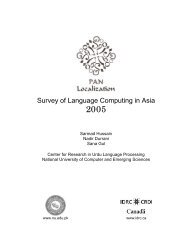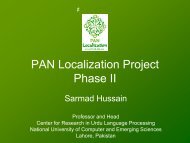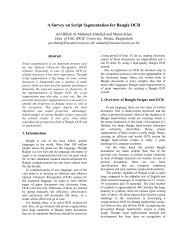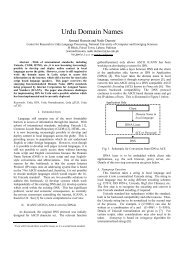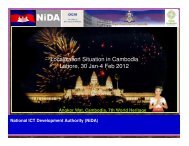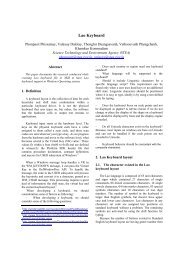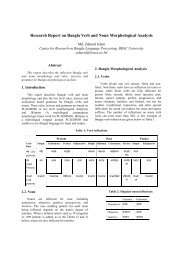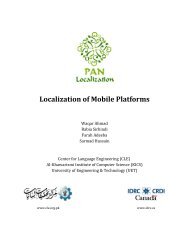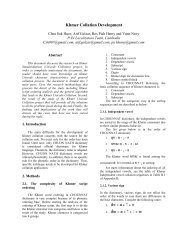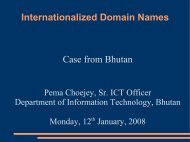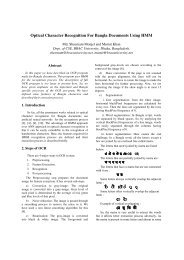Festival-si: A Sinhala Text-to-Speech System - PAN Localization
Festival-si: A Sinhala Text-to-Speech System - PAN Localization
Festival-si: A Sinhala Text-to-Speech System - PAN Localization
You also want an ePaper? Increase the reach of your titles
YUMPU automatically turns print PDFs into web optimized ePapers that Google loves.
<strong>Festival</strong>-<strong>si</strong>: A <strong>Sinhala</strong> <strong>Text</strong>-<strong>to</strong>-<strong>Speech</strong> <strong>System</strong><br />
Ruvan Weera<strong>si</strong>nghe, Asanka Wasala, Viraj Welgama and Kumudu Gamage<br />
Language Technology Research Labora<strong>to</strong>ry, Univer<strong>si</strong>ty of Colombo School of Computing,<br />
35, Reid Avenue, Colombo 00700, Sri Lanka<br />
arw@ucsc.cmb.ac.lk,<br />
{awasala,vwelgama,kgamage}@webmail.cmb.ac.lk<br />
Abstract. This paper brings <strong>to</strong>gether the development of the first <strong>Text</strong>-<strong>to</strong>-<br />
<strong>Speech</strong> (TTS) system for <strong>Sinhala</strong> u<strong>si</strong>ng the <strong>Festival</strong> framework and practical<br />
applications of it. Construction of a diphone database and implementation of the<br />
natural language proces<strong>si</strong>ng modules are described. The paper also presents the<br />
development methodology of direct <strong>Sinhala</strong> Unicode text input by rewriting<br />
letter-<strong>to</strong>-sound rules in <strong>Festival</strong>'s context sen<strong>si</strong>tive rule format and the<br />
implementation of <strong>Sinhala</strong> syllabification algorithm. A Modified Rhyme Test<br />
(MRT) was conducted <strong>to</strong> evaluate the intelligibility of the synthe<strong>si</strong>zed speech<br />
and yielded a score of 71.5% for the TTS system described.<br />
1 Introduction<br />
In this paper, we describe the implementation and evaluation of a <strong>Sinhala</strong> text-<strong>to</strong>speech<br />
system based on the diphone concatenation approach. The <strong>Festival</strong> framework<br />
[1] was chosen for implementing the <strong>Sinhala</strong> TTS system. The <strong>Festival</strong> <strong>Speech</strong><br />
Synthe<strong>si</strong>s <strong>System</strong> is an open-source, stable and portable multilingual speech synthe<strong>si</strong>s<br />
framework developed at the Center for <strong>Speech</strong> Technology Research (CSTR), of the<br />
Univer<strong>si</strong>ty of Edinburgh.<br />
TTS systems have been developed u<strong>si</strong>ng the <strong>Festival</strong> framework for different<br />
languages including English, Japanese [1], Welsh [12], [2], Turkish [9], and Hindi<br />
[5], [8], Telugu [3], [5], among others. However, no serious <strong>Sinhala</strong> speech<br />
synthe<strong>si</strong>zer has been developed this far. This is the first known documented work on a<br />
<strong>Sinhala</strong> text-<strong>to</strong>-speech synthe<strong>si</strong>zer. The system is named “<strong>Festival</strong>-<strong>si</strong>” in accordance<br />
with common practice.<br />
The rest of this paper is organized as follows: Section 2 gives an overview of the<br />
<strong>Sinhala</strong> phonemic inven<strong>to</strong>ry; Section 3 explains the diphone database construction<br />
process; the implementation of natural language proces<strong>si</strong>ng modules is explained in<br />
section 4. Section 5 discusses the potential applications while Section 6 presents an<br />
evaluation of the current system. The work is summarized and future research<br />
directions and improvements are discussed in the last section.
2 <strong>Sinhala</strong> Phonemic Inven<strong>to</strong>ry<br />
<strong>Sinhala</strong> is one of the official languages of Sri Lanka and the mother <strong>to</strong>ngue of the<br />
majority - 74% of its population. Spoken <strong>Sinhala</strong> contains 40 segmental phonemes; 14<br />
vowels (/i/, /i:/, /e/, /e:/ ,/æ/, /æ:/, /ə/, /ə:/, /u/, /u:/, /o/, /o:/, /a/, /a:/) and 26 consonants<br />
as clas<strong>si</strong>fied below in Table 1 [4].<br />
Labial Dental Alveolar Retroflex Palatal Velar Glottal<br />
S<strong>to</strong>ps p b t̪ d̪ ʈ ɖ k g<br />
Affricates<br />
ʧ ʤ<br />
Pre-nasalized<br />
voiced s<strong>to</strong>ps<br />
m b n d̪ ɳ ɖ ŋ g<br />
Nasals m n ɲ ŋ<br />
Trill<br />
r<br />
Lateral<br />
l<br />
Fricatives f v s ʃ h<br />
Approximants<br />
j<br />
Table 1. Spoken <strong>Sinhala</strong> Consonant Clas<strong>si</strong>fication<br />
3 Diphone Database Construction<br />
This section describes the methodology adopted in the construction of <strong>Sinhala</strong><br />
diphone database.<br />
Prior <strong>to</strong> constructing the diphone database, the answers <strong>to</strong> the following two<br />
questions were investigated [9]: What diphone-pairs exist in the language? What<br />
carrier words should be used?. Generally, the number of diphones in a language is<br />
roughly the square of the number of phones. Therefore, 40 phonemes for <strong>Sinhala</strong><br />
identified in section 2 suggest roughly 1600 diphones should exist. The first phase<br />
involved the preparation of matrices mapping all pos<strong>si</strong>ble combinations of consonants<br />
and vowels; i.e. CV, VC, VV, CC, _V, _C, C_ and, V_. Here ‘_’ denotes a short<br />
period of <strong>si</strong>lence. In the second phase, redundant diphones were marked <strong>to</strong> be omitted<br />
from the recording. Due <strong>to</strong> various phonotactic constraints, not all phone-phone pairs<br />
occur phy<strong>si</strong>cally. (for instance, diphone “ m b- ŋ g” never occurs in <strong>Sinhala</strong>). All such<br />
non-existent diphones were identified after consulting a linguist. Finally, 1413<br />
diphones were determined.<br />
The third phase involved in finding the answer <strong>to</strong> the second question; What carrier<br />
words should be used?; In other words, <strong>to</strong> compile set of words each containing an<br />
encoded diphone. Following the guidelines given in the Festvox manual [1] it was<br />
decided <strong>to</strong> record nonsense words containing the targeted diphone. These nonsense<br />
words were embedded in carrier sentences including four other nonsen<strong>si</strong>cal context<br />
words. A care was taken when coining these nonsen<strong>si</strong>cal words, so that these words<br />
act in accordance with phonotactics of the <strong>Sinhala</strong> language. The diphone is extracted<br />
from the middle syllable of the middle word, minimizing the articula<strong>to</strong>ry effects at the
start and end of the word. Also, the use of nonsen<strong>si</strong>cal words helped the speaker <strong>to</strong><br />
maintain a neutral prosodic context. The output of the third phase was 1413 sentences.<br />
The fourth phase involved recording the sentences. A native profes<strong>si</strong>onal male<br />
speaker chosen for recording practiced the intelligibility and pronunciation of the<br />
sentences. He was advised <strong>to</strong> maintain a constant pitch, volume, and fairly constant<br />
speech rate during the recording. In order <strong>to</strong> maintain all of the above stated aspects,<br />
recordings were limited <strong>to</strong> two 30-minute ses<strong>si</strong>ons per day. At each ses<strong>si</strong>on, 100<br />
sentences were recorded on average.<br />
Recording was done in a profes<strong>si</strong>onal studio with an optimum noise free<br />
environment. Initially the sentences were directly recorded <strong>to</strong> Digital Audio Tapes,<br />
and later transferred in<strong>to</strong> wave files, redigiti<strong>si</strong>ng at 44.1 kHz/16 bit quantization.<br />
The most tedious and painstaking tasks were carried out in the fifth phase where<br />
the recordings were split in<strong>to</strong> individual files, and diphone boundaries hand-labeled<br />
u<strong>si</strong>ng the speech analy<strong>si</strong>s software <strong>to</strong>ol ‘Praat’ 1 . Afterwards, a script was written <strong>to</strong><br />
transform Praat text-grid collection file in<strong>to</strong> diphone index file (EST) as required by<br />
<strong>Festival</strong> [1].<br />
The method for synthe<strong>si</strong>s used in this project is Re<strong>si</strong>dual Excited Linear Predictive<br />
Coding (RELP Coding). As required by this method, pitch marks, Linear Predictive<br />
Coding (LPC) parameters and LPC re<strong>si</strong>dual values had <strong>to</strong> be extracted for each<br />
diphone in the diphone database. The script make_pm_wave provided by speech<br />
<strong>to</strong>ols [1] was used <strong>to</strong> extract pitch marks from the wave files. Then, the make_lpc<br />
command was invoked in order <strong>to</strong> compute LPC coefficients and re<strong>si</strong>duals from the<br />
wave files [1]. Having tested synthe<strong>si</strong>zing different diphones, several diphones were<br />
identified problematic. An analy<strong>si</strong>s of the errors revealed that most were due <strong>to</strong><br />
incorrect pitch marking caused by the use of default parameters when extracting the<br />
pitch marks. The accurate parameters obtained by analyzing samples of speech with<br />
Praat were set in the scripts as per the guidelines given in [8]. Moreover, it was<br />
realized that lowering the pitch of the original wave files resulted in a more lucid<br />
speech. A proprietary software <strong>to</strong>ol was used <strong>to</strong> lower the recorded pitch, and<br />
normalize it in terms of power so that all diphones had an approximately equivalent<br />
power. Subsequently, modified make_pm_wave and make_lpc scripts were used<br />
<strong>to</strong> extract the necessary parameters from the wave files. These overall post-proces<strong>si</strong>ng<br />
steps <strong>si</strong>gnificantly improved the voice quality.<br />
A full listing of the scripts used for recording and creating the diphone database is<br />
available for download from http://www.ucsc.cmb.ac.lk/ltrl/projects/<strong>si</strong>.<br />
4 Natural Language Proces<strong>si</strong>ng Modules<br />
When building a new voice u<strong>si</strong>ng Festvox [1], templates of the natural language<br />
proces<strong>si</strong>ng modules required by <strong>Festival</strong> are au<strong>to</strong>matically generated as Scheme files.<br />
The NLP modules should be cus<strong>to</strong>mized according <strong>to</strong> the language requirements.<br />
Hence, the language specific scripts (phone, lexicon, <strong>to</strong>kenization) and speaker<br />
specific scripts (duration and in<strong>to</strong>nation) can be externally configured and<br />
1<br />
Available from: http://www.praat.org
implemented without recompiling the system [1], [9]. The NLP related tasks involved<br />
when building a new voice are [1], [5]: defining the phone-set of the language,<br />
<strong>to</strong>kenization and text normalization, incorporation of letter-<strong>to</strong>-sound rules,<br />
incorporation of syllabification rules, as<strong>si</strong>gnment of stress patterns <strong>to</strong> the syllables in<br />
the word, phrase breaking, as<strong>si</strong>gnment of duration <strong>to</strong> phones and generation of f0<br />
con<strong>to</strong>ur.<br />
4.1 The Phone Set Definition<br />
The identified phone-set for <strong>Sinhala</strong> in section 2 is implemented in the file festvox/<br />
ucsc_<strong>si</strong>n_sdn_phoneset.scm. The proposed set of symbol scheme is found <strong>to</strong> be a<br />
versatile representation scheme for <strong>Sinhala</strong> phone-set. Along with the phone symbols,<br />
features such as vowel height, place of articulation and voicing are defined. Apart<br />
from the default set of features, new features that are useful in describing <strong>Sinhala</strong><br />
phones are also defined. e.g. whether a consonant is pre-nasalized or not. These<br />
features will prove extremely useful when implementing prosody.<br />
4.2 Tokenization and <strong>Text</strong> Normalization<br />
The default text <strong>to</strong>kenization methodology implemented in <strong>Festival</strong> (which is based<br />
on whitespace, and punctuation characters) is used <strong>to</strong> <strong>to</strong>kenize <strong>Sinhala</strong> text. Once the<br />
text has been <strong>to</strong>kenized, text normalization is carried out. This step converts digits,<br />
numerals, abbreviations, and non-alphabetic characters in<strong>to</strong> word sequence depending<br />
on the context. <strong>Text</strong> normalization is a non trivial task. Therefore, prior <strong>to</strong><br />
implementation, it was decided <strong>to</strong> analyze running text obtained from a corpus. <strong>Text</strong><br />
obtained from the category “News Paper > Feature Articles > Other” of the UCSC<br />
<strong>Sinhala</strong> corpus BETA was chosen due <strong>to</strong> the heterogeneous nature of these texts and<br />
hence better representation of the language in this section of the corpus 2 . A script was<br />
written <strong>to</strong> extract sentences containing digits from the text corpus. The issues were<br />
identified by thoroughly analyzing the sentence. Strategies <strong>to</strong> address these issues<br />
were devised. A function is implemented <strong>to</strong> convert any number (decimal or integer<br />
up <strong>to</strong> 1 billion) in<strong>to</strong> spoken words.<br />
In <strong>Sinhala</strong>, the conver<strong>si</strong>on of common numbers is probably more complicated<br />
when compared <strong>to</strong> English. In certain numerical expres<strong>si</strong>ons, the number may be<br />
concluded from a word suffix. e.g. 5න් pahen (out of five), 1 වැනි paləvæni (1st). Such<br />
expres<strong>si</strong>ons are needed <strong>to</strong> be identified by taking in<strong>to</strong> con<strong>si</strong>deration the added suffix<br />
in a post-proces<strong>si</strong>ng module. A function is implemented <strong>to</strong> expand abbreviations in<strong>to</strong><br />
full words. Common abbreviations found by the corpus analy<strong>si</strong>s are listed, but our<br />
architecture allows easy incorporation of new abbreviations and corresponding words.<br />
In some <strong>si</strong>tuations, the word order had <strong>to</strong> be changed. For example, 50% must be<br />
expanded as “සියයට පනහ” - <strong>si</strong>jəjəʈə panəha (percent hundred), 50m should be<br />
expanded as මීටර් පනහ - mi:ʈər panəha (meters fifty). All above mentioned functions<br />
2<br />
This accounts for almost two-thirds of the <strong>si</strong>ze of this ver<strong>si</strong>on of the corpus
are called effectively by analyzing the context, and then accurate expan<strong>si</strong>ons are<br />
obtained.<br />
The <strong>to</strong>kenization and text normalization modules are implemented in festvox/<br />
ucsc_<strong>si</strong>n_sdn_<strong>to</strong>kenizer.scm and capable of normalizing elements such as numbers,<br />
currency symbols, ratios, percentages, abbreviations, Roman numerals, time<br />
expres<strong>si</strong>ons, number ranges, telephone numbers, email addresses, English letters and<br />
various other symbols.<br />
4.3 Letter-<strong>to</strong>-Sound Conver<strong>si</strong>on<br />
The letter-<strong>to</strong>-sound module is used <strong>to</strong> convert an orthographic text in<strong>to</strong> its<br />
corresponding phonetic representation. <strong>Sinhala</strong> being a phonetic language has an<br />
almost one-<strong>to</strong>-one mapping between letters and phonemes.<br />
We implemented the grapheme <strong>to</strong> phoneme (G2P) conver<strong>si</strong>on architecture<br />
proposed by Wasala et al. in [10]. In this architecture, the UTF-8 textual input is<br />
converted <strong>to</strong> ASCII based phonetic representation defined in the <strong>Festival</strong>. This<br />
process takes place at the user-interface level. Owing <strong>to</strong> the con<strong>si</strong>derable delay<br />
experienced when synthe<strong>si</strong>zing the text, it was decided <strong>to</strong> re-write the above G2P<br />
rules in the <strong>Festival</strong>’s context sen<strong>si</strong>tive format [1]. The rules were re-written in UTF-8<br />
multi-byte format following the work done for Telugu language [3]. The method was<br />
proven <strong>to</strong> work well cau<strong>si</strong>ng no delay at all. The 8 rules proposed in [10] expanded up<br />
<strong>to</strong> 817 rules when re-written in context sen<strong>si</strong>tive format. However, some frequently<br />
encountered important words were found incorrectly phonetized by these rules.<br />
Hence, such words along with their correct pronunciation forms were included in<br />
<strong>Festival</strong>’s addenda, a part lexicon. The letter-<strong>to</strong>-sound rules and lexicon are<br />
implemented in festvox/ucsc_<strong>si</strong>n_lexi.scm.<br />
<strong>Festival</strong>’s UTF-8 support is still incomplete; however, we believe the above<br />
architecture as the best <strong>to</strong> deal with Unicode text input in <strong>Festival</strong> over other proposed<br />
methods [12], [10].<br />
4.4 Syllabification & Stress As<strong>si</strong>gnment<br />
Instead of <strong>Festival</strong>’s default syllabification function lex.syllabify.phstress<br />
based on sonority sequencing profile [1], a new function (syllabify ‘phones)<br />
is implemented <strong>to</strong> syllabify <strong>Sinhala</strong> words. In this work, syllabification algorithm<br />
proposed by Weera<strong>si</strong>nghe et al. [11] is implemented. This algorithm is reported <strong>to</strong><br />
have 99.95% accuracy [11]. The syllabification module is implemented in<br />
festvox/ucsc_<strong>si</strong>n_sdn_syl.scm.<br />
4.5 Phrase Breaking Algorithm<br />
The as<strong>si</strong>gnment of in<strong>to</strong>national phrase breaks <strong>to</strong> the utterances <strong>to</strong> be spoken is an<br />
important task in a text-<strong>to</strong>-speech system. The presence of phrase breaks in the proper<br />
po<strong>si</strong>tions of an utterance affects the meaning, naturalness and intelligibility of speech.<br />
There are two methods for predicting phrase breaks in <strong>Festival</strong>. The first is <strong>to</strong> define a
Clas<strong>si</strong>fication and Regres<strong>si</strong>on Tree (CART). The second and more elaborate method<br />
of phrase break prediction is <strong>to</strong> implement a probabilistic model u<strong>si</strong>ng probabilities of<br />
a break after a word based on the part of speech of the neighboring words and the<br />
previous word [1]. However, due <strong>to</strong> the unavailability of a Part-of-<strong>Speech</strong> (POS), and<br />
a POS tagger for <strong>Sinhala</strong>, probabilistic model cannot be constructed yet. Thus, we<br />
opted for the <strong>si</strong>mple CART based phrase breaking algorithm described in [1]. The<br />
algorithm is based on the assumption that phrase boundaries are more likely between<br />
content words and function words. A rule is defined <strong>to</strong> predict a break if the current<br />
word is a content word and the next is seemingly a function word and the current<br />
word is more than 5 words from a punctuation symbol.<br />
This algorithm, initially developed for English, has proved <strong>to</strong> produce reasonable<br />
results for <strong>Sinhala</strong> as well. The phra<strong>si</strong>ng algorithm is defined in<br />
festvox/ucsc_<strong>si</strong>n_sdn_phrase.scm.<br />
4.6 Prosodic Analy<strong>si</strong>s<br />
Prosodic analy<strong>si</strong>s is minimal in the current system and will be implemented in the<br />
future. The major challenge for building prosody for <strong>Sinhala</strong> is the lack of a POS tagset,<br />
POS tagger and tagged text corpus. An experiment was carried out <strong>to</strong> adapt<br />
CART trees generated for an English voice prosody (f0 & duration) modules in<strong>to</strong><br />
<strong>Sinhala</strong>. The CART trees were carefully modified <strong>to</strong> represent the <strong>Sinhala</strong> Phone-set.<br />
The phone duration values were also hand modified <strong>to</strong> incorporate natural phone<br />
durations. The above steps resulted in more natural speech when compared <strong>to</strong> the<br />
mono<strong>to</strong>nous speech produced before incorporating them. These adapted modules<br />
(cmu_us_kal_dur.scm, cmu_us_kal_int.scm) are incorporated <strong>to</strong> the <strong>Festival</strong>-<strong>si</strong><br />
system.<br />
5 Integration with Different Platforms<br />
<strong>Festival</strong> offers a powerful platform for the development and deployment of speech<br />
synthe<strong>si</strong>s systems. Since most Linux distributions now come with <strong>Festival</strong> preinstalled,<br />
the integration of <strong>Sinhala</strong> voice in such platforms is very convenient.<br />
Furthermore, following the work done for <strong>Festival</strong>-te, the <strong>Festival</strong> Telugu voice [3],<br />
the <strong>Sinhala</strong> voice developed here was made acces<strong>si</strong>ble <strong>to</strong> GNOME-Orca 3 and<br />
Gnopernicus 4 - powerful as<strong>si</strong>stive screen reader software for people with visual<br />
impairments.<br />
Motivated by the work carried out in the Welsh & Irish <strong>Speech</strong> Proces<strong>si</strong>ng<br />
Resources (WISPR) project [12], steps were taken <strong>to</strong> integrate <strong>Festival</strong> along with the<br />
<strong>Sinhala</strong> voice in<strong>to</strong> the Microsoft <strong>Speech</strong> Application Programming Interface (MS-<br />
SAPI) which provides the standard speech synthe<strong>si</strong>s and speech recognition interface<br />
within Windows applications [13]. As a result of this work, the MS-SAPI compliant<br />
<strong>Sinhala</strong> voice is acces<strong>si</strong>ble via any speech enabled Windows application. We believe<br />
3<br />
Available from: http://live.gnome.org/Orca<br />
4<br />
Available from: http://www.baum.ro/gnopernicus.html
that the visually impaired community would be benefited at large by this exercise<br />
owing <strong>to</strong> the prevalent use of Windows in the community. The <strong>Sinhala</strong> voice also<br />
proved <strong>to</strong> work well with Thunder 5 a freely available screen reader for Windows.<br />
This will cater <strong>to</strong> the vast demand for a screen reader capable of speaking <strong>Sinhala</strong><br />
text. It is noteworthy <strong>to</strong> mention that for the first time the print disabled community in<br />
Sri Lanka will be able <strong>to</strong> work on computers in their local language by u<strong>si</strong>ng the<br />
current <strong>Sinhala</strong> text-<strong>to</strong>-speech system.<br />
6 Evaluation<br />
<strong>Text</strong>-<strong>to</strong>-speech systems can be compared and evaluated with respect <strong>to</strong> intelligibility,<br />
naturalness, and suitability for used application [6]. As the <strong>Sinhala</strong> TTS system is a<br />
general-purpose synthe<strong>si</strong>zer, a deci<strong>si</strong>on was made <strong>to</strong> evaluate it under the<br />
intelligibility criterion.<br />
A Modified Rhyme Test (MRT) [6], [9] was de<strong>si</strong>gned <strong>to</strong> test the <strong>Sinhala</strong> TTS<br />
system. The test con<strong>si</strong>sts of 50 sets of 6 one or two syllable words which makes a<br />
<strong>to</strong>tal set of 300 words. The words are chosen <strong>to</strong> evaluate phonetic characteristics such<br />
as voicing, nasality, <strong>si</strong>bilation, and consonant germination. Out of 50 sets, 20 sets<br />
were selected for each listener. The set of 6 words is played one at the time and the<br />
listener marks the synthe<strong>si</strong>zed word. The overall intelligibility of the system from 20<br />
listeners is found <strong>to</strong> be 71.5%. According <strong>to</strong> the authors' knowledge, this is the only<br />
reported work in the literature describing the development of a <strong>Sinhala</strong> text-<strong>to</strong>-speech<br />
system, and more importantly the first <strong>Sinhala</strong> TTS system <strong>to</strong> be evaluated u<strong>si</strong>ng the<br />
stringent Modified Rhyme Test.<br />
7 Conclu<strong>si</strong>ons and Future Work<br />
In this paper we described the development and evaluation of the first TTS system for<br />
<strong>Sinhala</strong> language based on the <strong>Festival</strong> architecture. The de<strong>si</strong>gn of a diphone database<br />
and the natural language proces<strong>si</strong>ng modules developed have been described.<br />
Future work will mainly focus on improving the naturalness of the synthe<strong>si</strong>zer.<br />
Work is in progress <strong>to</strong> improve the prosody modules. A speech corpus containing 2<br />
hours of speech has been already recorded. The material is currently being segmented,<br />
and labeled. We are also planning <strong>to</strong> improve the duration model u<strong>si</strong>ng the data<br />
obtained from the annotated speech corpus. A number of other ongoing projects are<br />
aimed at developing a POS tag set, POS tagger and a tagged corpus for <strong>Sinhala</strong>.<br />
Further work will focus on expanding the pronunciation lexicon. At present, the<br />
G2P rules are incapable of providing accurate pronunciation for most compound<br />
words. Thus, we are planning <strong>to</strong> construct a lexicon con<strong>si</strong>sting of compound words<br />
along with common high frequency words found in our <strong>Sinhala</strong> text corpus, which are<br />
currently incorrectly phonetized.<br />
5<br />
Available from: http://www.screenreader.net/
Acknowledgement<br />
This work was made pos<strong>si</strong>ble through the <strong>PAN</strong> <strong>Localization</strong> Project,<br />
(http://www.<strong>PAN</strong>L10n.net) a grant from the International Development Research<br />
Center (IDRC), Ottawa, Canada, administered through the Center for Research in<br />
Urdu Language Proces<strong>si</strong>ng, National Univer<strong>si</strong>ty of Computer and Emerging Sciences,<br />
Pakistan.<br />
References<br />
1. Black, A.W., Lenzo, K.A.: Building Synthetic Voices, Language Technologies<br />
Institute, Carnegie Mellon Univer<strong>si</strong>ty and Cepstral LLC. Retrieved from:<br />
http://festvox.org/bsv/ (2003)<br />
2. Jones, R.J., Choy, A., Williams, B.: Integrating <strong>Festival</strong> and Windows. Inter<strong>Speech</strong><br />
2006. 9th International Conference on Spoken Language Proces<strong>si</strong>ng, Pittsburgh, USA<br />
(2006)<br />
3. Kamisetty, C., Adapa, S.M.: Telugu <strong>Festival</strong> <strong>Text</strong>-<strong>to</strong>-<strong>Speech</strong> <strong>System</strong>. Retrieved from:<br />
http://festival-te.sourceforge.net/wiki/Main_Page (2006)<br />
4. Karunatillake, W.S.: An Introduction <strong>to</strong> Spoken <strong>Sinhala</strong>, 3rd edn., M.D. Gunasena &<br />
Co. ltd., 217, Olcott Mawatha, Colombo 11 (2004)<br />
5. Kishore, S.P., Sangal, R., Srinivas, M.: Building Hindi and Telugu Voices u<strong>si</strong>ng<br />
Festvox. Proceedings of the International Conference On Natutal Language<br />
Proces<strong>si</strong>ng 2002 (ICON-2002), Mumbai (2002)<br />
6. Lemmetty, S.: Review of <strong>Speech</strong> Synthe<strong>si</strong>s Technology, MSc. the<strong>si</strong>s, Hel<strong>si</strong>nki<br />
Univer<strong>si</strong>ty of Technology (1999)<br />
7. Louw, A.: A Short Guide <strong>to</strong> Pitch-Marking in the <strong>Festival</strong> <strong>Speech</strong> Synthe<strong>si</strong>s <strong>System</strong><br />
and Recommendations for Improvement. Local Language <strong>Speech</strong> Technology<br />
Initiative (LLSTI) Reports. Retrieved from: http://www.llsti.org/documents.htm<br />
(n.d.)<br />
8. Ramakishnan, A.G., Bali, K., Talukdar, P.P., Krishna, N.S.: Tools for the<br />
Development of a Hindi <strong>Speech</strong> Synthe<strong>si</strong>s <strong>System</strong>, In 5th ISCA <strong>Speech</strong> Synthe<strong>si</strong>s<br />
Workshop, Pittsburgh (2004) 109-114<br />
9. Salor, Ö., Pellom, B., Demirekler, M.: Implementation and Evaluation of a <strong>Text</strong>-<strong>to</strong>-<br />
<strong>Speech</strong> Synthe<strong>si</strong>s <strong>System</strong> for Turkish. Proceedings of Eurospeech-Interspeech 2003,<br />
Geneva, Switzerland. (2003) 1573-1576<br />
10. Wasala, A., Weera<strong>si</strong>nghe, R., Gamage, K.: <strong>Sinhala</strong> Grapheme-<strong>to</strong>-Phoneme<br />
Conver<strong>si</strong>on and Rules for Schwa Epenthe<strong>si</strong>s. Proceedings of the COLING/ACL 2006<br />
Main Conference Poster Ses<strong>si</strong>ons, Sydney, Australia (2006) 890—897<br />
11. Weera<strong>si</strong>nghe, R., Wasala, A., Gamage, K.: A Rule Based Syllabification Algorithm<br />
for <strong>Sinhala</strong>, Proceedings of 2nd International Joint Conference on Natural Language<br />
Proces<strong>si</strong>ng (IJCNLP-05). Jeju Island, Korea (2005) 438-449<br />
12. Williams, B., Jones, R.J., Uemlianin, I.: Tools and Resources for <strong>Speech</strong> Synthe<strong>si</strong>s<br />
Ari<strong>si</strong>ng from a Welsh TTS Project. Fifth Language Resources and Evaluation<br />
Conference (LREC), Genoa, Italy (2006)<br />
13. Microsoft Corporation.: Microsoft <strong>Speech</strong> SDK Ver<strong>si</strong>on 5.1. Retrieved from:<br />
http://msdn2.microsoft.com/en-s/library/ms990097.aspx (n.d.)



